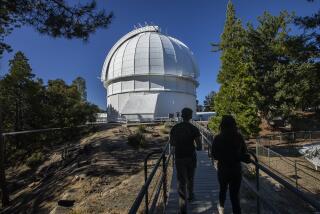Star Pupil Handles Big Astronomy Problem
- Share via
Some 30,000 light-years from the center of the Milky Way, a cosmic message jolted Gwen Bell from bed: The Ulsa Minor and Sculptor galaxies are repelling each other.
Realizing that she had drawn her vectors wrong, Bell flipped on her computer and began to finally make some headway on the problem that had stumped her for weeks.
Now, the American Physical Society is honoring Bell--a first-year graduate student at Caltech--for coming up with what could be the most accurate estimate of the mass of the Milky Way.
In pounds, that would be a 3 with 42 zeros after it.
“I think it’s one of the best determinations that’s been done,” said Barrett Ripin, associate executive officer of the American Physical Society. “And it’s one of the best pieces of undergraduate work I’ve seen in years.”
Bell, who had never looked through a telescope before entering college, did much of her research during a summer program at the U.S. Naval Observatory in Flagstaff, Ariz., and during her senior year at Harvey Mudd College in Claremont.
Her work is yet to be published, but a presentation of her research earned the prestigious $6,000 Leroy Apker Award for undergraduates.
“Typically, the winners come up with some new approach to doing something,” said Ripin, “or, as in Bell’s case, they do it better.”
Bell will be honored in March at a national conference of the American Physical Society, which gives the award each year.
“I think she did a beautiful piece of work,” said Andrea Ghez, a UCLA astronomy professor, who is using similar technique to measure the mass of a black hole at the galaxy’s center.
Traditionally, astronomers have estimated the galaxy’s mass by counting its stars. But scientists now believe that a substantial portion of the Milky Way’s mass is “dark matter,” an unknown substance that cannot be seen.
So Bell used another approach, based on the behavior of smaller galaxies--so-called dwarf spheroidals--that orbit the Milky Way. Their speed depends on the strength of the gravity that keeps them leashed in orbit, like the moon around the Earth. The greater the mass of a planet or galaxy, the more gravitational force it exerts. So Bell could estimate the mass of the Milky Way in the same way someone could weigh the sun by watching Pluto.
She calculated that our galaxy weighs as much as 700 billion suns, give or take a hundred billion. Recent scientific estimates have run as high as 2 trillion solar masses.
Bell managed her work while balancing her other classes with more down-to-earth endeavors, such as dorm parties and college doughnut-eating contests.
“My philosophy is to work hard and play hard,” she said.
She doesn’t have the pallor of many hard-core science students who rarely emerge outside to see the Earth’s closest star. Bell jogs and hikes. She was social representative for her dorms, and wasn’t contemplating the cosmos at college parties.
She grew up near Berkeley, always did well in school, but dabbled in history, film and economics before focusing on astronomy.
Her interest in galaxies comes from curiosity about solving puzzles with physical laws, she said, not from any romantic or cosmic mystique.
“We all get into science because we want to solve mysteries,” she said.
She was picked for a prestigious summer program at the U.S. Naval Observatory, the institution with the task, among others, of keeping the nation’s time. Her supervisor, astronomer Stephen Levine, figured that weighing the Milky Way would make a nice summer project.
“I tried to get something she could really wrap her fingers around,” he said. “And she just had a knack for it.”
Levine gave her the problem and then left her alone, he said. At summer’s end, he said, he was struck by her graduate-level quality of work. When Bell finished in Flagstaff, she continued working on the problem during her final year at Harvey Mudd.
Although her work is yet to pass through a critical peer review process, astronomers said this kind of research could have an impact on the field.
Steve Majewski, a University of Virginia astronomer whose research tracking the two dwarf spheroidals was the foundation for Bell’s research, said determining the galaxy’s mass could eventually lead to significant discoveries, like explaining dark matter.
The problem with weighing the Milky Way is that it doesn’t have a defined outer edge. So, there is no way of telling where the galaxy ends because it seems to just fade out, like a wispy ball.
The most accurate measurements of mass must come from orbiting satellites farthest from the center of the galaxy, scientists say, which are less likely to lie within the Milky Way’s halo of dark matter.
Other astronomers have recently tried to measure the galaxy by tracking orbiting celestial bodies just as Bell did. But the farthest out they measured was the Magellanic Cloud, the closest orbiting galaxy, which may lie within the Milky Way’s halo, and thus not account for the weight beyond its orbit, said Levine.
Bell’s estimation is based on the Ulsa Minor and Sculptor galaxies, which lie far beyond the Magellanic Cloud.
Majewski said measurements of the galaxy are gradually improving as more research tracking the orbiting galaxies becomes available.
Bell, meanwhile, is determined to succeed in an overpopulated and underpaid field where women are traditionally underrepresented.
“It’s really hard to be in a field where you don’t see yourself reflected,” she said. “You get attitude like, ‘You’re pretty smart for a girl.’ ”







